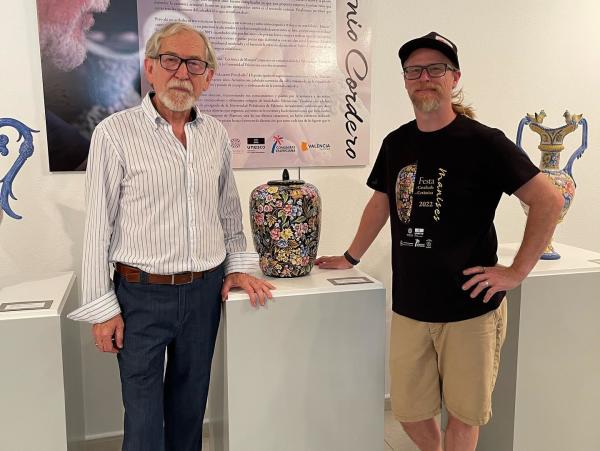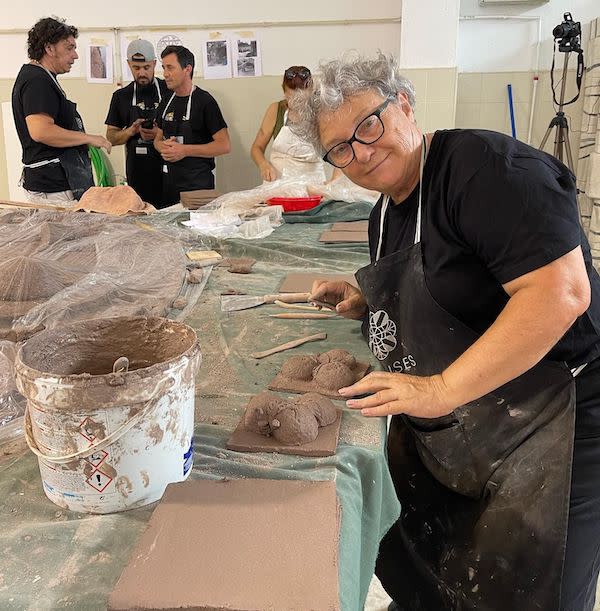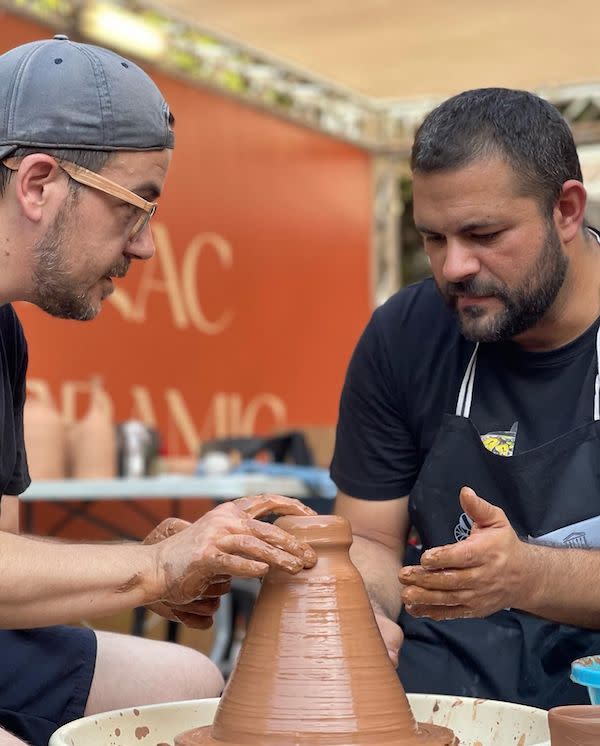Living the life of an artist in Paducah Creative City you never know what doors will open—at home or far away in a unique culture somewhere across the globe. In 2022, on the heels of Paducah’s 10-year anniversary as a UNESCO Creative City, opportunity knocked for ceramist/art educator Mitch Kimball to participate in the centuries old Fiesta de la Cerámica [Ceramics Festival] in Manises, Spain, a fellow UNESCO Creative City of Crafts & Folk Art.

Mitch poses with Manises ceramic artist Antonio Cordero.
Manises is a Mediterranean municipality situated near the banks of the Turia River in the province of Valencia. The creative community boasts a population of approximately 30,000. Manises’ many artists, museums, colorful architecture, and educational facilities have transformed it into a living ceramic landscape, which is a protected by law and continues to be a time-honored driver for the city’s economic growth. These criteria laid the foundation for their successful designation into the UNESCO Creative Cities Network in 2021.
Manises’ annual Ceramics Festival signature events feature traditions that have been handed down for generations! A prestigious Biennale, sidewalk artists selling their wares, a street fireworks battle, a paella (a rice and meat or fish dish that originated in Valencia) contest that’s a block long, and a historic parade that honors the Patron Saints of Ceramists, husband and wife team Santa Justa and Santa Rufina, are just a few of the highlights that showcase this city recognized as the birthplace of ceramics.
The opportunity to be immersed in Manises, whose cultural identity dates back to the 13th century, was a dream come true for Mitch. Knowing he would be honoring the tradition of giving back to the community made it even more appealing. Each day, Mitch and Daniel and Carlos from Portugal, another mutual UNESCO Creative City, worked alongside local potters to create a ceramic mural on a wall that was formerly the location of a clock at an old landmark train station similar to Paducah’s historic Freight House. “Touching clay helps my soul,” said Mitch. “The fact that I was able to make something—every day—and get to work with clay…that was really important.”

Local potters worked together on a mural wall project at the historic train station.
Though the work schedule was a daily event, the food and festivities focused around the Ceramics Festival made it even more memorable. One of the surprising happenings was the fireworks that announced the celebration. A self-proclaimed pyromaniac, Mitch loves fire, in the sky or in his kiln, where his hand-sculpted clay creations are transformed into beautiful functional artworks. He was prepared for a dynamic display in the sky; however, Manises staged an unexpected event unique to the Spanish culture. It began with a procession of shooters dressed in safety gear and face shields who proceeded to a controlled area where they threw firecrackers and Roman candles at each other. “It’s a battle in a cage—not in the sky,” said Mitch. “It was thrilling to watch as the crowd moved further and further back to maintain a safe distance.”
On another afternoon, Mitch and his friends took to the streets to participate in a parade that gave away thousands of ceramics to the townspeople. The Festa y Cavalcada de la Ceràmica de Manises [Festival and Cavalcade of the Ceramics] parade is a deeply rooted tradition unique to this colorful community. Two 12-ft tall papier mache puppets, representing Santa Justa and Santa Rufina, led the procession. Floats stacked with boxes of ceramics paraded through the streets as artists and City Council members handed out more than 40,000 pieces of local handcrafted souvenirs to the crowd. “Everybody was given box cutters but you had no idea what was inside the boxes,” said Mitch. “It’s like when we have a parade and we’re giving out candy—only they’re giving out ceramics.” People were rushing the floats and hoping for a ‘plato’—one of 200 honorary hand-painted plates created for the occasion. “It was non-stop,” said Mitch. “The excitement was overwhelming.”

Potters moved their studios to the streets to demonstrate and sell their wares.
A country’s cuisine is a tasty reflection of its culture—aioli (cold garlic and olive oil emulsion), paella, and food cooked in clay were everywhere. “I’m a foodie and plate flipper,” said Mitch. "Going to a restaurant and seeing what they put their food on is huge for me!" A Manises restaurant that had a reputation for serving the best aged shaved beef in Spain opened exclusively for the mural artists. Though everyone else ordered the steak, Mitch’s menu item of choice was rabbit. “Everyone’s steaks looked the same and were all served on the same style of plate, but the rabbit…it was EXQUISITE,” he muses. The rabbit had been cooked all day in a handmade ceramic casserole dish. The chef was so proud, he personally carried it out to the table of artists knowing they would appreciate the beauty of this functional ware. “I want to make THOSE dishes,” said Mitch.

Mitch enjoyed rabbit served and baked in a ceramic dish created by a local potter.
Though Manises boasts a long history as the cradle of ceramics, the International Ceramics Biennale, organized by the Manises Town Hall and held at the Ceramics Museum, is one of its most important contemporary cultural events. The Biennale links tradition with modern-day ceramics and features forums, seminars, and talks as well as visits to factories and studios. The juried exhibition brings together present-day artists from nearly 40 countries. The XV Ceramic Biennial was special for the community for two reasons: it had to be postponed in 2021 due to the pandemic, and it was the first time they could celebrate their UNESCO Creative City designation. “It was nice to see American ceramics artists that I value as true players in the field get into the Biennale along with newcomers and contemporary artists from places like Africa and Egypt,” said Mitch. “Local artists were exhibiting alongside international artists and you really never knew who was who.”
Language was never a barrier to the fellowship and friendships that were forged as artists from different cultures meshed through this creative exchange. “Getting to work on a mural that’s going to be there indefinitely was super awesome. And working with Carlos and Daniel from Portugal…I’d say I made friends for life,” said Mitch. Though they did not speak a lot of English and Mitch did not speak Spanish, four simple words spoken from the heart—thank you, my friend—were repeated over and over as they greeted each other in the morning and before they left for the night. “It was so awesome. It was good for my soul and I think it was good for theirs.”

Mitch poses with a new friend, Manises artist Jaime Romero.
Though time has passed since his journey to Manises, the memories are still fresh and alive. Mitch fell in love with the people, and though he missed his family, it was bittersweet to leave. He is grateful that Paducah made it possible for him to be a part of the Manises Ceramics Festival. “As an art educator, it’s lovely to be able to make those connections,” said Mitch. “I’ve been making connections with fellow artists from other countries for over a decade now and I still stay in touch. We’re busy people, and for some reason or another we take a little bit of our life and we put it on pause and live in the moment to make a memory and a bond. Would I have ever done that just being a teacher? No…I wouldn’t have.”
The door of opportunity for artist exchanges swings both ways, as Paducah also welcomes artists from mutual Creative Cities to experience our culture. In collaboration with the Paducah Convention & Visitors Bureau, Paducah Arts Alliance’s Artist in Residence Program opened its doors to Manises ceramist and food enthusiast Jaime Romero (April 2023) to commemorate Paducah’s 10-year Anniversary as a UNESCO Creative City.
“Without the Creative City connections, how would we invite people here? How would we know who to invite?” said Mitch. “Through UNESCO there’s a cultural connection…just connect their thread to your thread. There’s a commonality there to be found, and more people can come to the table to say ‘thank you’ and share their story. I see the value in it now.”
